Totality, corona, Baily's beads: Do you know your solar eclipse terminology?
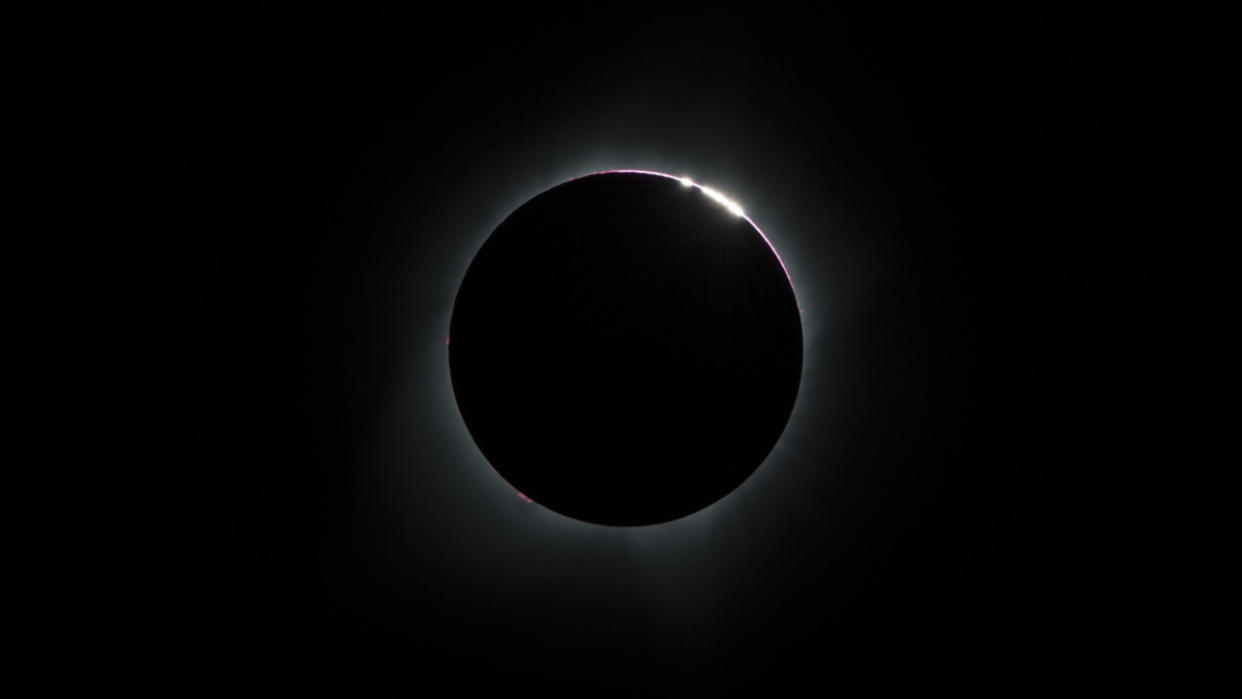
- Oops!Something went wrong.Please try again later.
There's a lot of jargon and terminology surrounding the April 8 total solar eclipse.
So, to help you sound like a seasoned umbraphile, here's a guide to demystify the words and phrases used to describe aspects of this spectacular astronomical event.
Partial Eclipse
Everyone in Canada will have a chance to see at least a partial eclipse during this event.
A partial eclipse is any time when only part of the Sun is covered by the Moon.
The farthest northwestern reaches of the country will only see a small sliver of the Sun covered by the Moon. Meanwhile, those areas just outside of the path of totality will experience an almost total eclipse, with over 99.9 per cent of the Sun covered by the Moon.
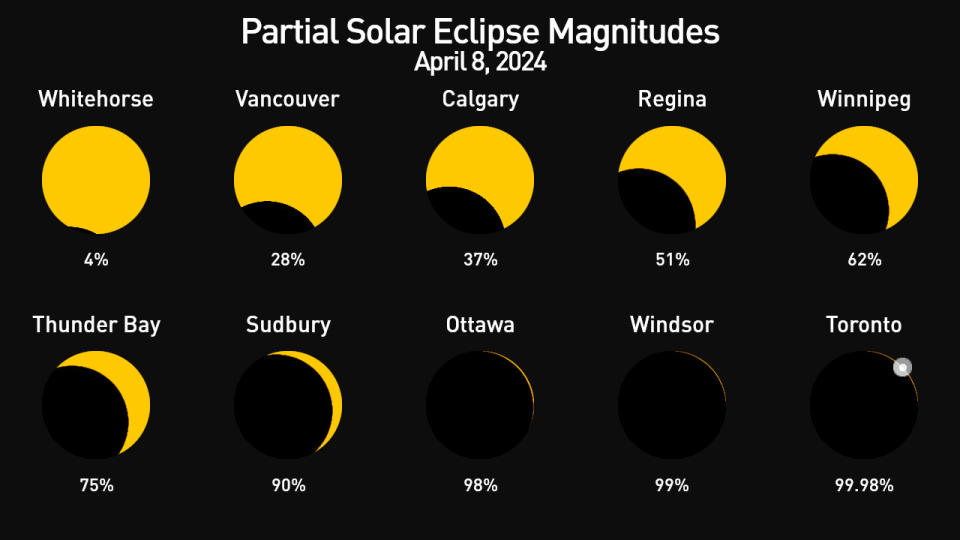
The above graphic includes the maximum partial eclipse viewable from ten different locations across Canada. Due to the path of this eclipse, the last three examples (Ottawa, Windsor, Toronto) also apply to many communities farther east — townships in eastern Ontario, Ottawa and Gatineau, northern Montreal, Trois-Rivières, Quebec City, Edmundston, Moncton, Saint John, Charlottetown, Halifax, Sydney, and St. John's.
Even observers that have a chance to witness the Moon completely block the Sun will still experience a partial eclipse for over 99 per cent of the event.
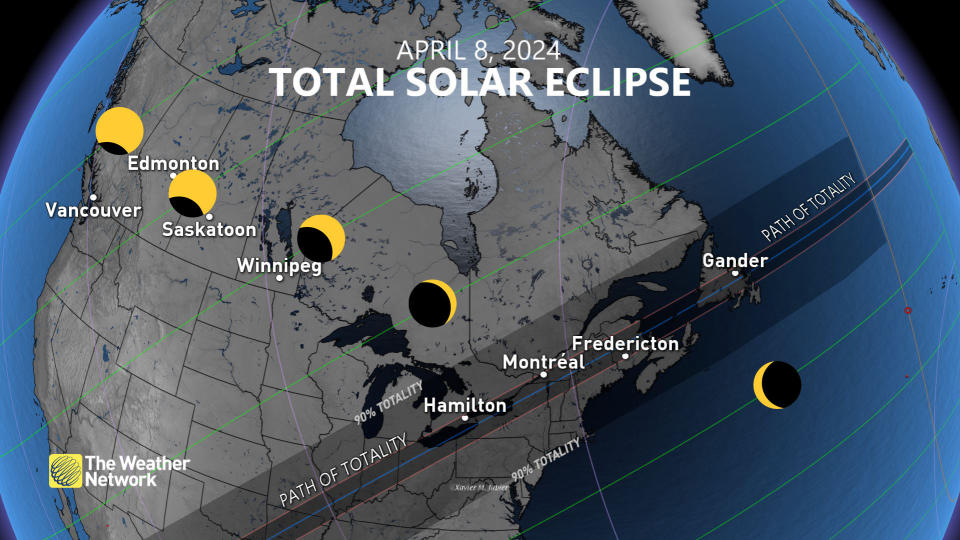
Remarkably, even a partial eclipse of up to 90 per cent isn't really enough to noticeably dim the Sun's brightness in our sky. Thus, anyone outside the gray-shaded part of the above map will probably not even notice that anything unusual is occurring on that day. From there, anyone with access to solar eclipse glasses or an indirect method of viewing will see the partial eclipse, but for everyone else, it may seem like just another Monday.
The partial eclipse is often discussed in 'magnitude', which is expressed as a fraction of the diameter of the Sun that is covered at any time.
DON'T MISS: Everything you need to know for April's spectacular and rare solar eclipse
Totality
Totality is the period of time during a total solar eclipse when the Moon completely blocks the Sun.
This is also the only time when it is safe for eclipse watchers to remove their eye protection.
In fact, those that experience totality are very much encouraged to remove their solar viewing glasses at that time. That way, they can see the solar corona surrounding the Moon.
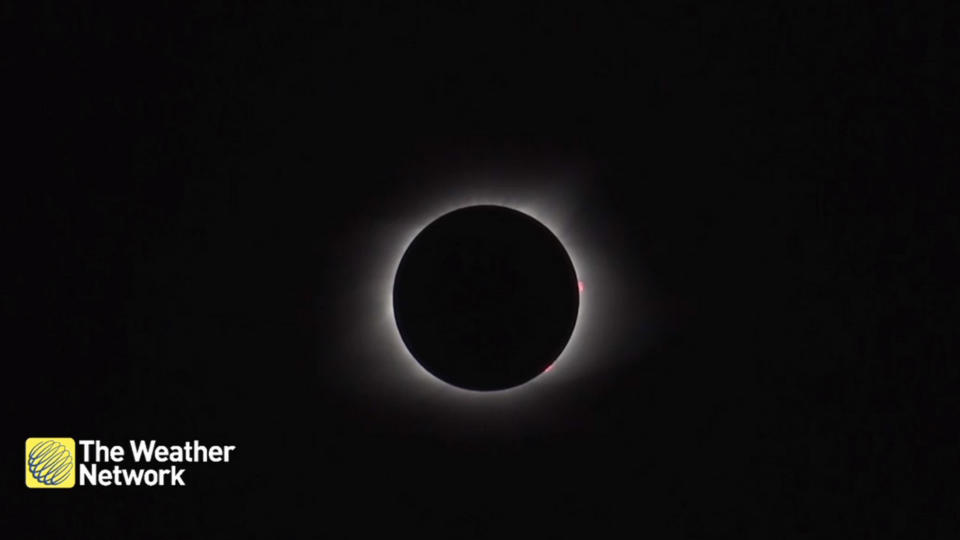
Be very careful to know exactly when totality ends for your location, though, so you can look away or put your eye protection back on before the Sun reappears from behind the Moon.
The maximum duration for totality for this solar eclipse is 4 minutes and 28 seconds, when viewed from northern Mexico. The farther you are from that location, the shorter totality will be.
In Canada, the longest totality will be seen from Fort Erie, ON, with a duration of 3 minutes and 46 seconds. In Bonavista, Nfld, at the far end of the path of totality, the Moon will completely block the Sun for 2 minutes and 54 seconds.
Path of Totality
The path of totality is the narrow corridor that the deepest part of the Moon's shadow follows as it crosses the face of the Earth.
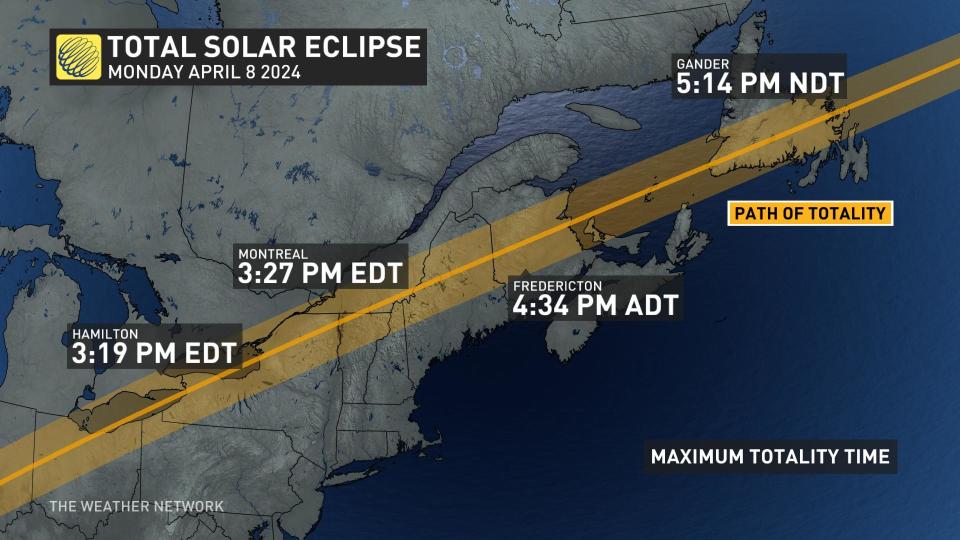
It is only from within this path that viewers will experience the awe-inspiring sight of the total solar eclipse.
Within this roughly 200-km-wide corridor, the longest durations for totality will be along the centre line of the path.
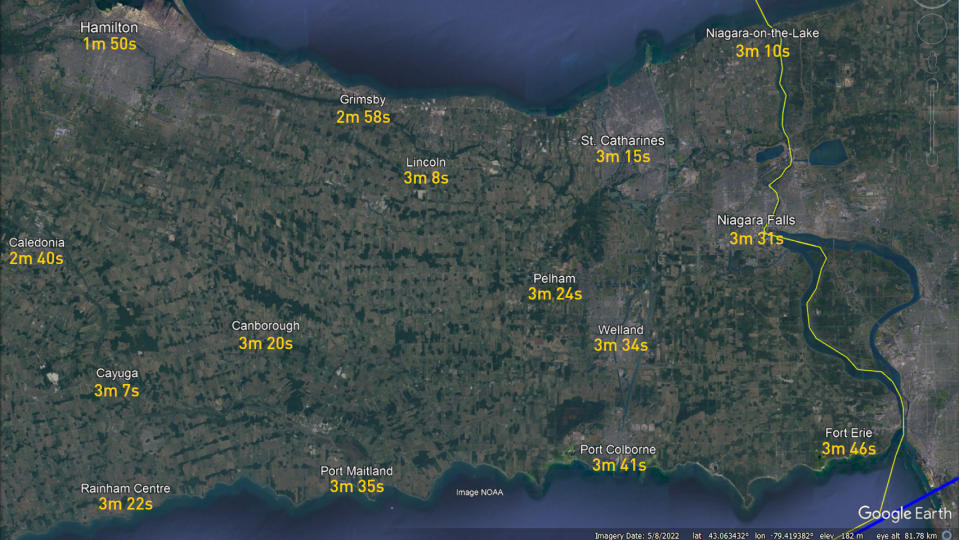
As shown in the map above, the farther away a viewer is from that centre line, the shorter totality will be. While Fort Erie has a totality duration of 3 minutes and 46 seconds, St Catharines will see it for 3 minutes and 15 seconds, while Hamilton will only experience totality for just shy of 2 minutes.
Umbra & Penumbra
The umbra and penumbra are the two parts of the Moon's shadow that are cast upon Earth's surface during a total solar eclipse.
The umbra is the dark core of the shadow, while the penumbra is the more diffuse part of the shadow that surrounds the umbra.
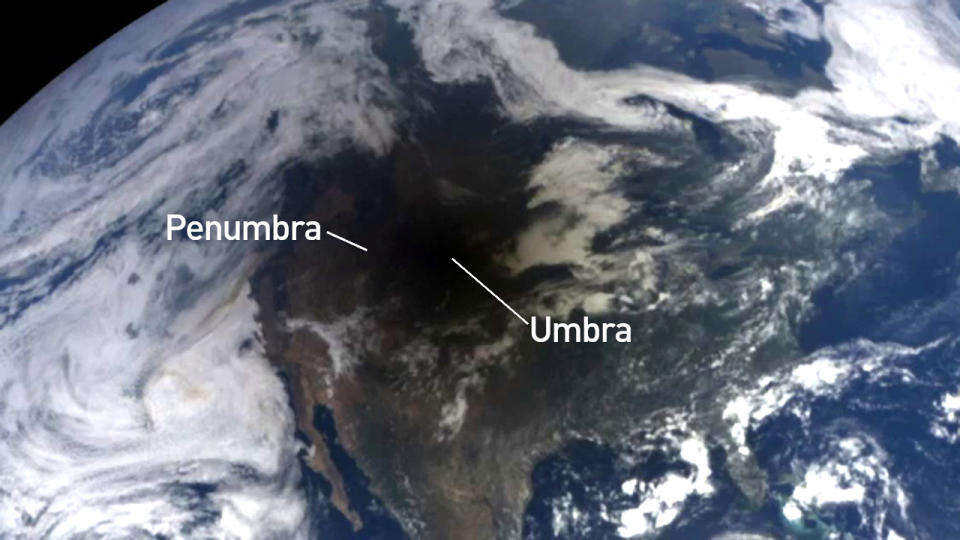
The Moon's dark umbra and diffuse penumbra are labelled on this image captured by the Deep Space Climate Observatory on August 21, 2017. Credit: NASA/NOAA/Scott Sutherland
Anyone who is viewing the partial solar eclipse (indirectly or while wearing eye protection, of course) will be in the penumbra at that time.
Those who can look up and see the Moon completely blocking the Sun, at 100 per cent totality, will be in the dark umbra. The sky will turn a bizarre shade of blue at that time, possibly unlike anything you've ever seen before, winds will calm, birds will go quiet, and the temperature will drop noticeably. Also, there will be a wispy white glow surrounding the Moon, as the solar corona becomes visible.
By the way, an umbraphile is a person who will do everything they can, and go anywhere that is possible, to experience totality during a total solar eclipse.
READ MORE: How to use a cereal box to safely view the solar eclipse
Contact (First, Second, Third, Fourth)
Throughout the eclipse, if you are set up somewhere along the path of totality, you may hear someone call out phrases like "First Contact", "Second Contact", "Third Contact", and "Fourth Contact."
These terms refer to points of the eclipse when the leading and trailing edges of the Moon's disk make "contact" with parts of the Sun.
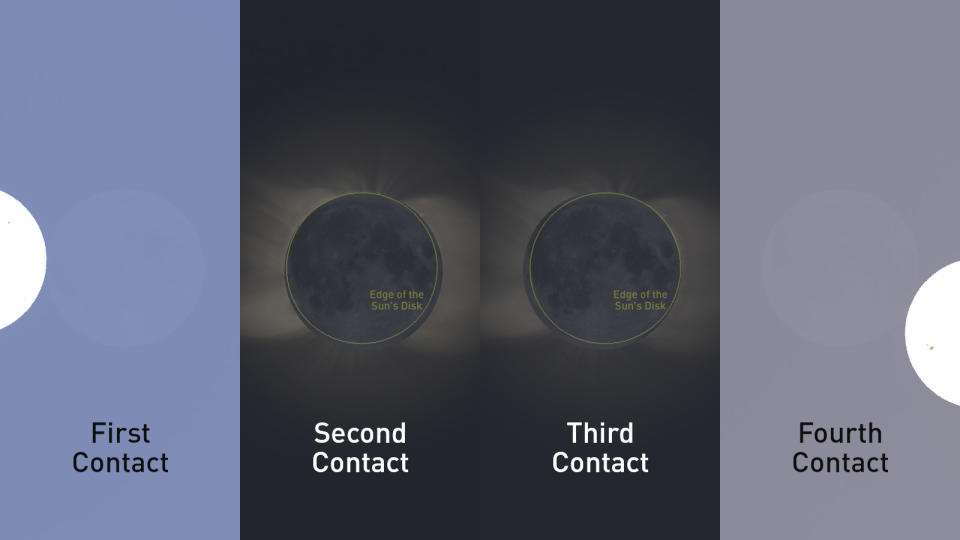
This graphic shows the four 'contacts' during a total solar eclipse. Since the Moon completely obstructs the Sun at Second and Third Contacts, the position of the Sun is indicated in those frames to better illustrate these points of the eclipse. Credit: Stellarium/Scott Sutherland
First contact is when the eastern limb of the Moon (the side leading the advance across the disk of the Sun) first touches the western limb of the Sun, and the partial eclipse begins.
Second contact is when the eastern limb of the Moon touches the eastern limb of the Sun, indicating the beginning of totality for that location. Right at this point is when it becomes safe to remove your eclipse glasses.
Third contact is when the western limb of the Moon (the trailing edge) meets with the western limb of the Sun, coinciding with the end of totality. Eclipse glasses go back on before this occurs!
Fourth contact is when the western limb of the Moon meets the eastern limb of the Sun, signalling the end of the eclipse.
Viewers outside the path of totality will only experience First Contact and Fourth Contact, skipping Second and Third. Those inside the path of totality will observe all four in sequence.
Shadow Bands
Just before and just after totality, when there is only a tiny sliver of the Sun still visible from behind the Moon, observers may witness something strange going on with shadows around them. This odd phenomenon is known as shadow bands.
According to NASA: "Shadow bands are thin wavy lines of alternating light and dark that can be seen moving and undulating in parallel on plain-coloured surfaces immediately before and after a total solar eclipse."
Watch below: Shadow bands seen before and after the November 2012 total solar eclipse across northern Australia
Unfortunately, shadow bands are not observed from all locations during an eclipse and not even during every eclipse. Also, their origin still remains something of a mystery, even today, but it is believed that they likely result from the same upper atmospheric turbulence that causes stars to twinkle.
Baily's Beads
About a minute and a half before totality begins, almost the entire disk of the Sun will be covered by the Moon, but several bright points of light will be visible just along the limb of the Moon.
These points of light are called Baily's beads, and are named for astronomer Francis Baily, who first described them.
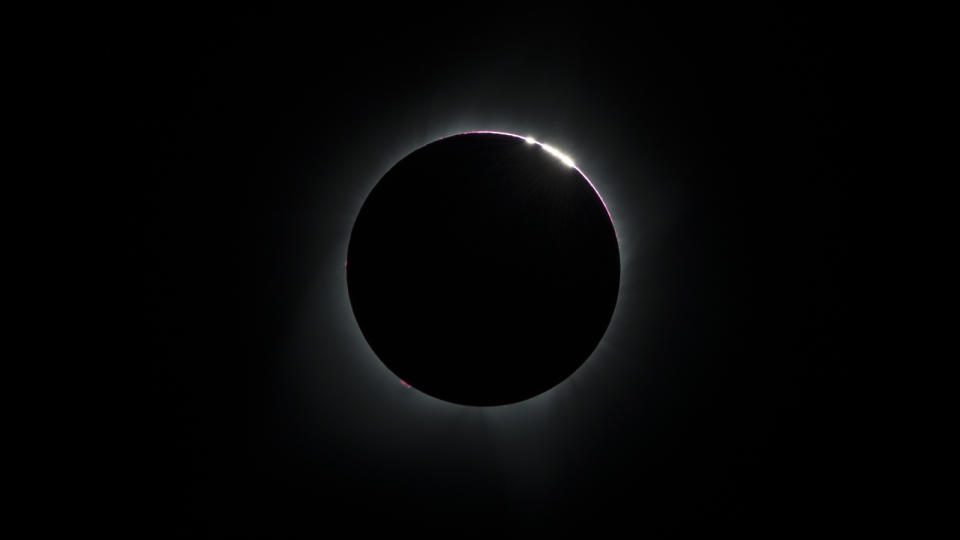
Baily's Beads, as seen during the August 2017 eclipse. Credit: NASA/Aubrey Gemignani
Baily's beads occur because the edge of the Moon is not a perfect circle. There are crater rims, mountains, hills, and valleys all along it. When over 99.9 per cent of the Sun is covered up by the Moon, the only parts of the star we can still see are those that peek through the valleys.
Separated by areas of higher elevation, it appears as though there is a string of bright beads along the limb of the Moon. This phenomenon will also appear for over a minute after totality ends.
Although only visible for up to 90 seconds from within the path of totality, some observers positioned just outside the path may see them for even longer.
Diamond ring
In the seconds just before totality, with only one Baily's bead remaining and the white glow of the corona becoming visible around the Moon, we will see the Diamond Ring.
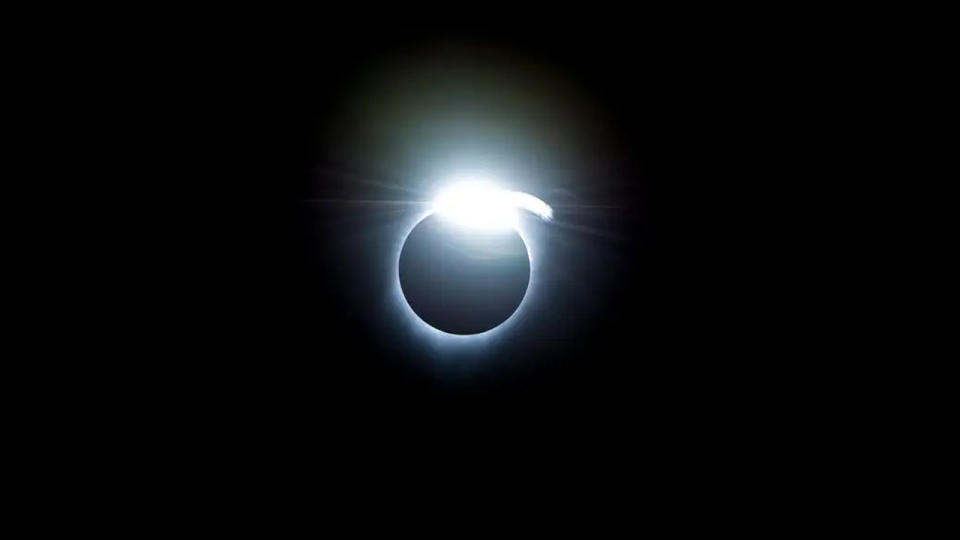
The diamond ring visible just before totality during the August 2017 total solar eclipse. Credit: NASA/Carla Thomas
This phenomenon is also visible just after Third Contact, when the first point of light from the Sun peaks through on the other side of the Moon.
The reason the diamond ring in the image above looks so much brighter than the Baily's beads in the previous picture is due to the photographer removing the solar filter from their camera just before totality.
The brightness of the 'diamond' in the 'ring' is an excellent indicator for why it is important to leave your eclipse glasses on until the Sun is completely covered by the Moon.
Although it lasts for only a second, with your eyes adapted to the dark (pupils wide open to bring in as much light as possible) this bright point can leave a spot before your vision.
RELATED: Strange things may happen during the eclipse, and NASA wants you to document it
Corona
During totality, observers can look up without eye protection to see the corona, the Sun's outer atmosphere, shining as a wispy white glow around the Moon.
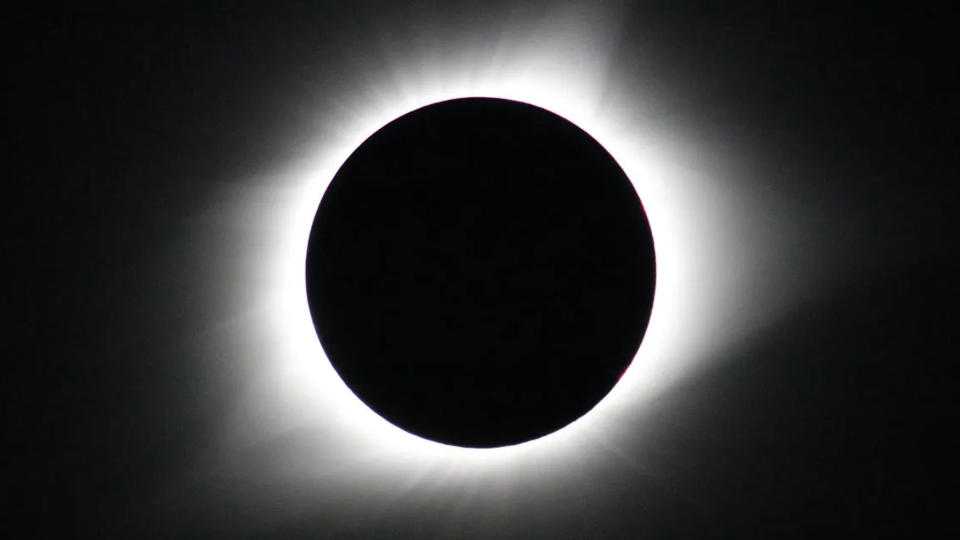
The solar corona is visible in this image taken during the 2017 total solar eclipse. Credit: NASA/Nat Gopalswamy
Viewing the corona is always awe-inspiring, but this year we may be in for an even better treat.
In August 2017, the solar eclipse occurred when the Sun was just a few years from the lowest point in its 11-year cycle of activity.
Now, we are just months away from the Sun being at the peak of its cycle. As such, we are seeing a lot more solar activity — sunspots, solar flares, and the like. Thus, the corona may be even brighter than it was in the last eclipse, and we could even see some added bonuses when the Moon completely covers the Sun.
Prominence
When the Sun is very active, we often see immense arcs of solar material extend out from the Sun's surface. These are often referred to as coronal loops, and they occasionally get launched away from the Sun during a solar flare.
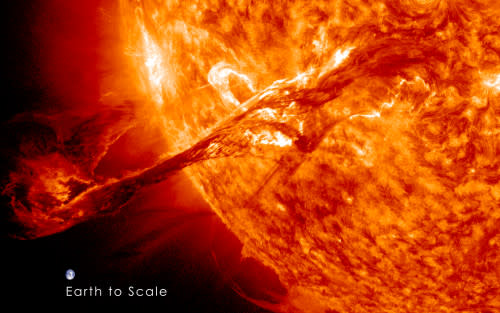
This massive solar prominence erupted from the Sun in 2012. Credit: NASA
However, we can also spot these along the limb of the Moon during a total solar eclipse.
In that case, we call them prominences.
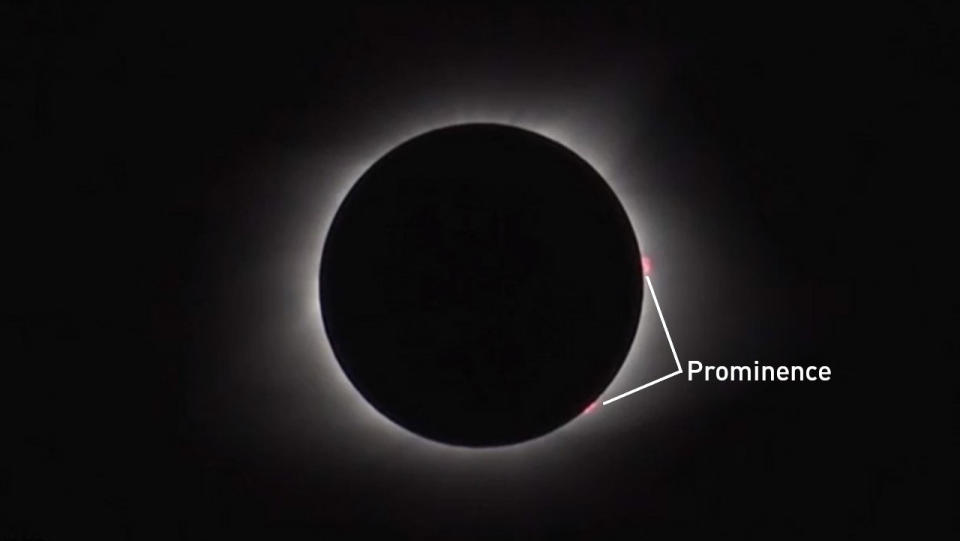
These seem to be a common sight during total solar eclipses, but we may see more of them, and more impressive examples of them, during this eclipse.
Coronal Mass Ejection
When a solar flare goes off on the surface of the Sun, there is a chance that any coronal loop (aka prominence) in its vicinity may erupt into space. This is known as a coronal mass ejection or CME.
Accelerated away from the Sun by the energy of the flare, a CME becomes an expanding cloud of charged solar particles that can cause magnetic disturbances and auroras if it sweeps past Earth.
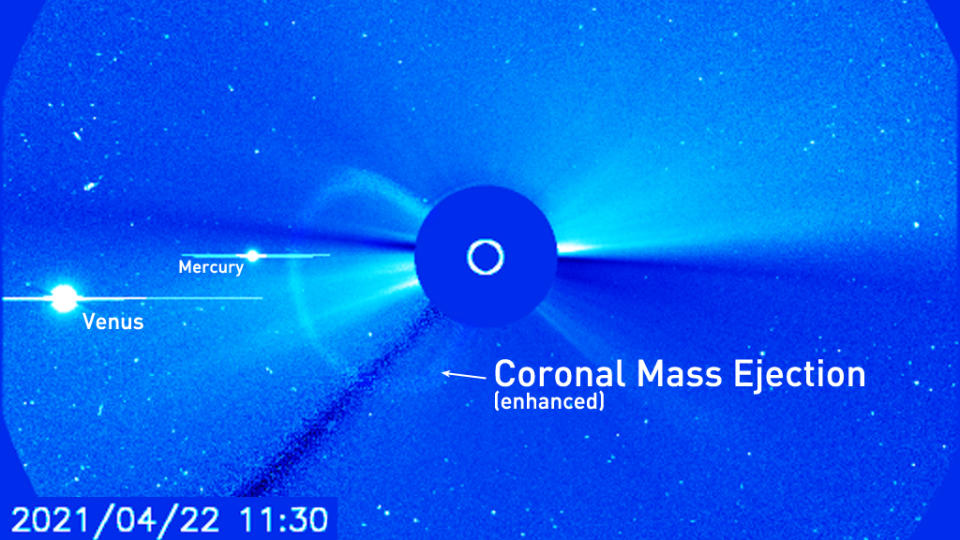
This view of a CME was captured by the coronagraph on the Solar and Heliospheric Observatory on April 22, 2021. Credit: NASA
Space weather scientists observe CMEs by using a camera, known as a coronagraph, which captures the dimmer activity around the Sun by blocking direct sunlight using a solid metal disk in front of the lens.
During a total solar eclipse, we have the Moon acting as a coronagraph for those of us viewing totality. If a CME were to erupt right at that time, we may catch a glimpse of it.
The cloud of expanding plasma might not be easily spotted with the naked eye (simply due to the size of the Sun in the sky), but cameras would be able to record the event.
Duration
For any solar eclipse, there is a length of time for the entire event, and then there is the duration.
For this solar eclipse, the time from First Contact to Fourth Contact varies based on your location — from a little over 2 hours and 20 minutes when viewed from around Niagara Falls, ON, to around 2 hours and 9 minutes from Gander, NL.
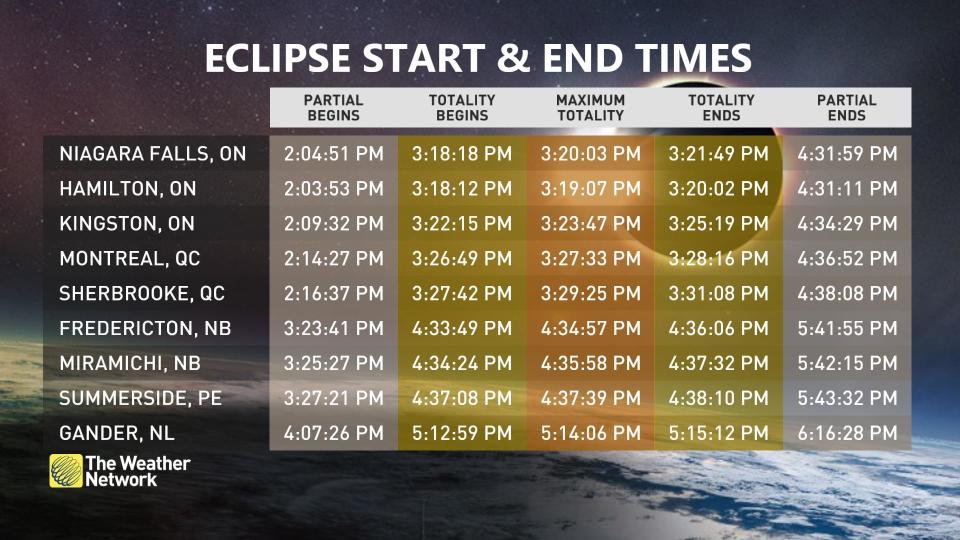
However, the duration of the eclipse is the length of totality from any location, thus the period of time between Second Contact and Third Contact.
The longest duration of the eclipse for Canada is 3 minutes and 46 seconds, as seen from Fort Erie, ON. In Gander, NL, it will be 2 minutes and 13 seconds, but areas closer to the edge of the path of totality will probably see totality for at least 90 seconds or so.

